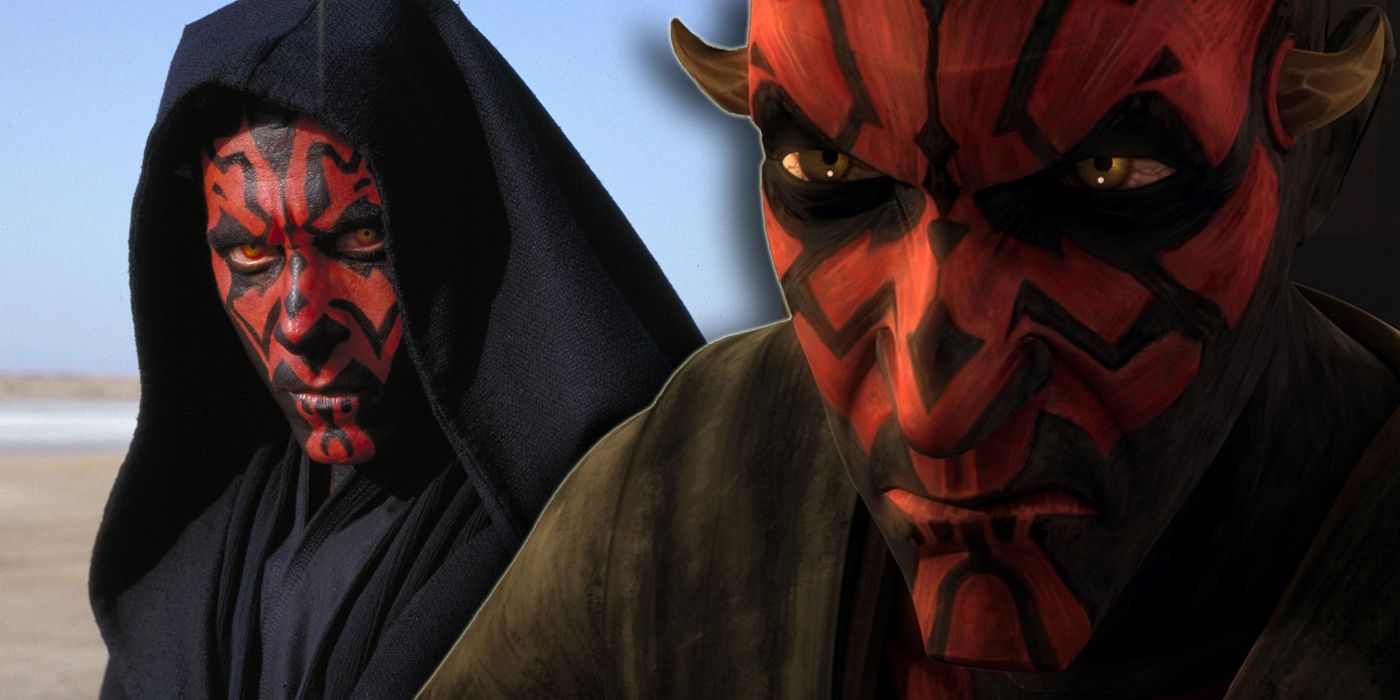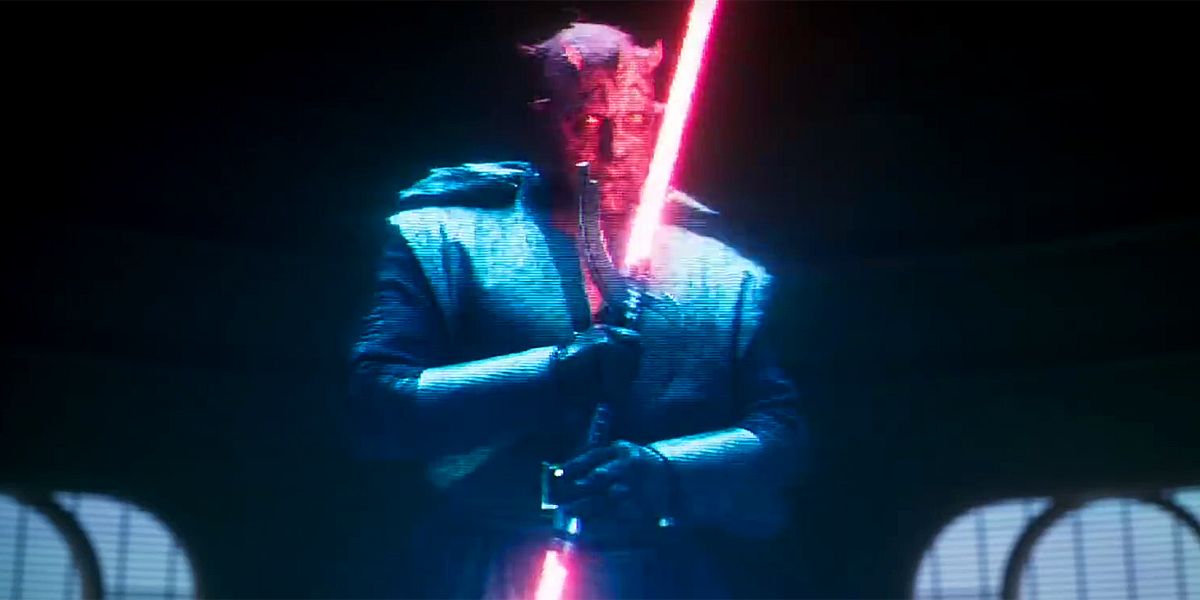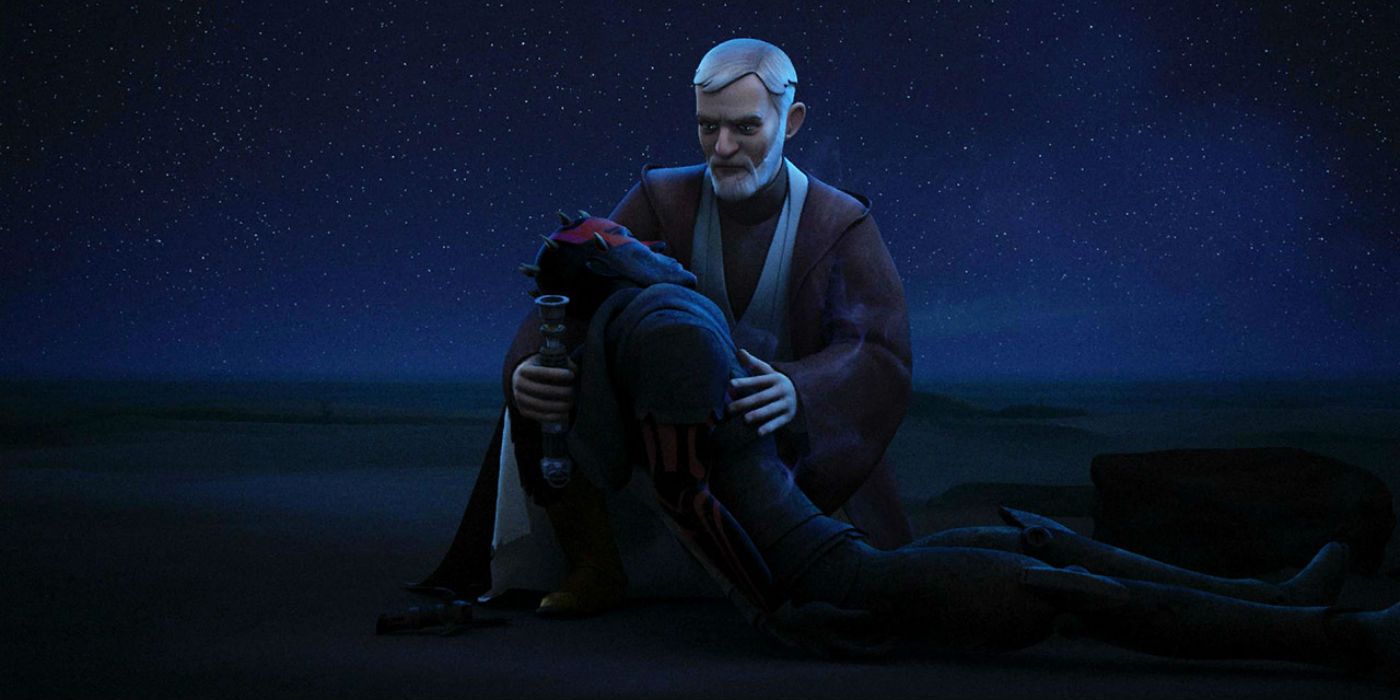Solo: A Star Wars Story ended with Darth Maul making a surprise appearance. While fans of the animated series Star Wars Rebels knew Maul survived his encounter with Obi-Wan Kenobi, it didn't seem likely we'd see him again. However, Solo's finale suggested Lucasfilm had more plans for the character. However, due to that film's disappointing box office, a sequel will never materialize. But with news of a possible live-action series on Disney+ focusing on Obi-Wan in his desert years, it seems probable Darth Maul and his sweet, baritone voice, the harbinger of evil but lucrative deeds, could make another return.
Thanks to Rebels, we know Darth Maul was thought to have died in Tatooine barely two years before A New Hope at the hands of Obi-Wan Kenobi. While we learn Maul was only there because he wanted to lure the Jedi out of hiding, the connection between his criminal organization Crimson Dawn and the desert planet is deeper, and could serve to link Maul and Obi-Wan Kenobi with The Mandalorian series.
Crimson Dawn started as the Shadow Collective, a Darth Maul-led enterprise composed of exiled Mandalorian warriors and criminal organizations like Black Sun, the Pyke Syndicate and the Hutt Clan. After the Mandalorian rebels "reconciled" with the Republic, and Chancellor Palpatine became the Emperor, Maul’s hold on the Shadow Collective faltered, but his influence did not disappear.
In the years between The Revenge of the Sith and Solo: A Star Wars Story, Crimson Dawn operated as a group of mercenaries that forced the natives to give up the resources they wanted. This brutalization is retold by Savareen’s Enfys Nest in Solo: “When the ravagers returned and demanded their tribute, the people shouted back with one voice. No more. So they cut out the tongue of every man, woman, and child. That was many years ago. Do you know what that pack of animals became?"
With time, Crimson Dawn formalized its criminal structure, although Maul preferred to act from the shadows and made sure the figurehead was a completely different person. This not only allowed him to operate free from the radars of both the Empire and the Resistance but also liberated him to pursue other goals, depicted in Star Wars: Rebels, such as exploring the Sith Pyramid of Malachor, trying to recruit Ezra Bridger as his apprentice and hunting down Obi-Wan Kenobi in the sands of Tatooine.
Maul dies in Tatooine in 2 BBY (Before the Battle of Yavin), but his appearance at the end of Solo takes place in 10 BBY, which leaves the showrunners of Obi-Wan Kenobi’s Disney+ series a lengthy period of 8 years in which to explore how the rise of Crimson Dawn’s activities affected the rest of the Galaxy, including Tatooine.
Exploring those 8 years would not only serve as a great framework for Obi-Wan's story, but it would also serve as a very personal one. Darth Maul was Qui-Gon Jinn’s killer, and we know from the Star Wars comics, novelizations, and the short story Master and Apprentice by Claudia Gray, that Obi-Wan spent much of his time in Tatooine communicating with his Qui-Gon Jinn's spirit.
Revenge was not a part of Obi-Wan’s motivations when he fought Maul in Rebels; he only took up the lightsaber when Maul threatened Luke and was even able to offer his enemy some comfort as he lay dying under the moons of Tatooine. However, who is to say he arrived at that balanced mindset immediately? After all, Qui-Gon’s death was what forced Obi-Wan to step up and train Anakin Skywalker; Obi-Wan feels incredibly guilty about the fall to the darkness of his apprentice, whose fault he carries squarely on his shoulders (at least at the beginning of his exile) – but he must have known he would have never been in the position to fail if Maul hadn’t killed his master.
Great stories give their characters external and internal motivations, and Obi-Wan has external motivations to spare: Tatooine’s inhospitable environment is perfect for a man versus the wild story. His self-imposed duty to protect Luke has already filled some volumes, and the hostility of the Hutts and the Tusken Raiders towards other desert dwellers is well documented. However, Obi-Wan’s internal evolution from his absolute distress at the end of Revenge of the Sith to his serene acceptance of the Force in A New Hope merits its own story, and Darth Maul would bridge the gap between the external circumstances of the Galaxy and Obi-Wan’s internal turmoil perfectly.
It is also of note that the parallels between both characters are astounding. Both Obi-Wan and Maul are forced into exile by the rise of the Empire, they are both forced to operate from the shadows to raise "a new sun," and both hope to pass on their knowledge to a reluctant apprentice. Most noteworthy, though, is that they even die within a short period of each other. The last words Darth Maul says to Obi-Wan are that the Chosen One will avenge them but what is there to avenge for both of them? Unless he's referring to the shared misery the Emperor's rise brought to both Obi-Wan and Darth Maul.
Darth Maul knew Obi-Wan was his nemesis, but did Obi-Wan know Darth Maul was his shadow?



